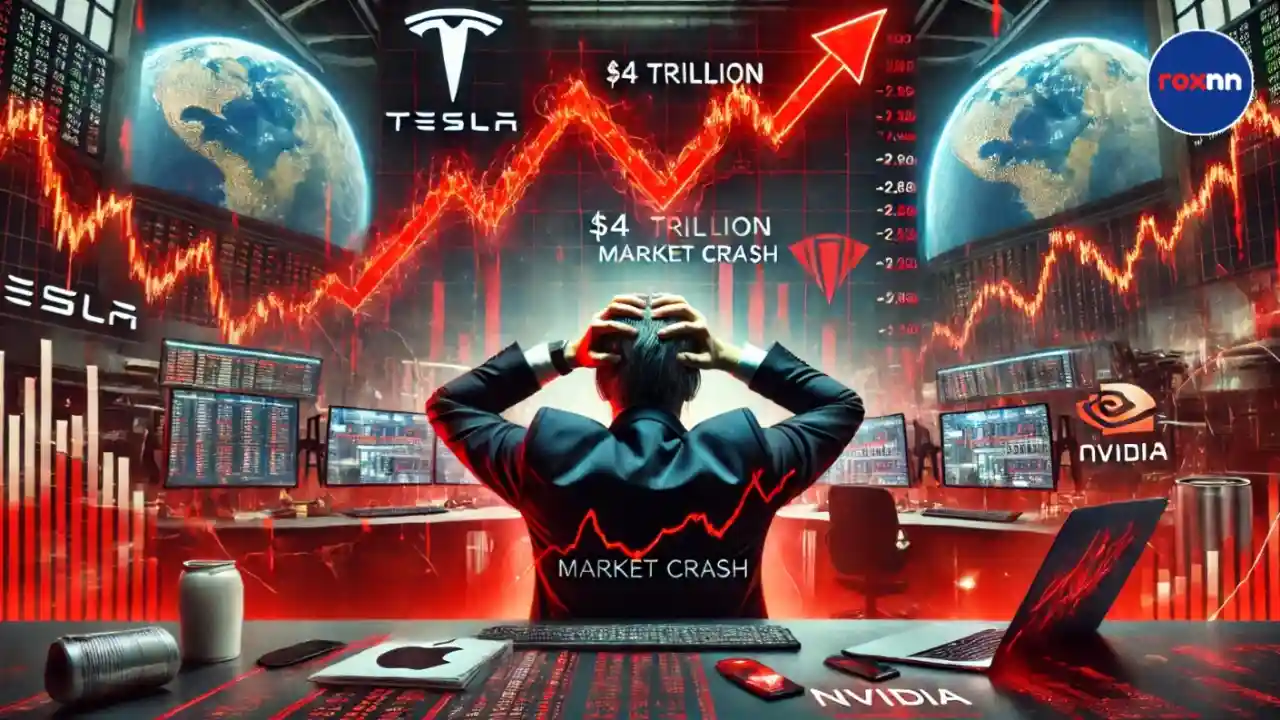On Monday, the U.S. stock market experienced one of its most shocking declines in recent times, wiping out nearly $4 trillion in market value. The trigger? A single remark from Donald Trump, where he refused to rule out the possibility of a recession in the United States.
This massive dip particularly hit tech stocks, with giants like Tesla, Apple, and Nvidia bearing the brunt. Tesla shares plunged by over 15%, wiping off a staggering $125 billion from its market cap, while Apple and Nvidia dropped around 5%.
This isn’t just a market fluctuation—it’s a clear signal of the growing economic uncertainty in the United States and the world’s reaction to evolving trade and fiscal policies under Trump’s leadership.
How Much Was Lost: A Comparison with Global Markets
To put things into perspective, the $4 trillion loss in the U.S. stock market is equivalent to the entire market capitalization of all companies listed on India’s BSE (Bombay Stock Exchange). That’s a staggering number, one that underscores how deeply Wall Street’s volatility can ripple across global economies.
| Region/Index | Market Value Lost | Equivalent Comparison |
|---|---|---|
| U.S. S&P 500 | ~$4 Trillion | Equal to BSE’s total market cap |
| Nasdaq Composite | 4% single-day drop | Largest since Sept 2022 |
| Tesla Market Cap | Lost $125 Billion | Most significant single-day loss in 2025 |
What Triggered This Massive Crash?
While Donald Trump’s recession warning was the tipping point, analysts believe there were several underlying factors contributing to this market bloodbath:
- Mounting trade tensions and tariff uncertainty
- Rising inflation concerns
- Volatility around Trump’s evolving economic policies
- Investor fear over potential monetary tightening
According to a UBS report, the probability of a U.S. recession has jumped from 20% to 30%, reflecting rising investor anxiety over future economic conditions.
Tech Sector Takes the Biggest Hit
Tech giants have taken a direct hit due to market fragility. Here’s a breakdown:
| Company | Price Drop (%) | Market Impact |
|---|---|---|
| Tesla | 15%+ | $125 Billion wiped out |
| Apple | ~5% | Billions in market value lost |
| Nvidia | ~5% | Negative sentiment on future growth |
Investors are now re-evaluating the risk-reward balance in high-growth tech stocks, especially those heavily dependent on global supply chains and sensitive to interest rate movements.
Impact on U.S. Indices: S&P 500 & Nasdaq in Decline
- S&P 500 fell 2.7% on Monday alone, and is now down 8.6% from its February highs.
- Nasdaq Composite plunged 4%, marking the biggest single-day drop since September 2022.
This kind of market behavior shows a clear risk-off sentiment where investors are fleeing from growth stocks into safer assets, possibly even preparing for an economic downturn.
Did Trump’s Re-election Boost Markets Earlier?
Interestingly, after Donald Trump was re-elected on November 5, there was a short-lived rally on Wall Street. But that optimism has now evaporated. Investors are beginning to see the aggressive tariff policies and uncertain economic agenda as potential threats rather than growth enablers.
Now, many fear that Trump’s protectionist measures could lead to trade disruptions, a slowdown in global growth, and eventually push the U.S. toward a recession.
How This Affects Global Markets
This Wall Street crash hasn’t stayed limited to the U.S. The global markets, including India, Europe, and Asia, are feeling the tremors:
- India’s Nifty 50 has dropped 15% from its September peak.
- Emerging markets are witnessing capital outflows.
- Global investors are shifting toward safe-haven assets like gold and U.S. Treasury bonds.
Is This the Beginning of a Bigger Recession?
Market experts are divided on whether this is just a correction or the start of a major recession:
- Optimists believe this is a short-term market overreaction, and medium-term growth potential remains intact.
- Cautious strategists, however, warn of higher political risks and economic instability in the coming quarters.
UBS continues to maintain a cautiously optimistic outlook, but advises investors to tread carefully, especially during the next 3–6 months.
Investor Strategy: What Should You Do Now?
If you’re a U.S. investor wondering what to do in this volatile market, here are some practical strategies:
- Diversify Your Portfolio – Don’t keep all eggs in one basket, especially not in tech.
- Focus on Long-Term Fundamentals – Avoid panic selling during short-term volatility.
- Watch for Policy Signals – Stay alert to government announcements and Fed actions.
- Consider Defensive Sectors – Utilities, healthcare, and consumer staples can offer stability.
- Monitor Global Trends – Keep an eye on foreign markets and economic reports.
Final Thoughts: A Wake-Up Call for the U.S. Economy
This $4 trillion market crash is not just about one statement—it’s about growing fragility in investor confidence, uncertainty in economic direction, and fear of a looming slowdown. Whether or not a recession hits, the message is clear: market stability hinges on consistent, transparent, and investor-friendly policies.
As we move forward, both individual investors and institutional players will need to make data-driven decisions, keeping political risks and macroeconomic signals in close view.

